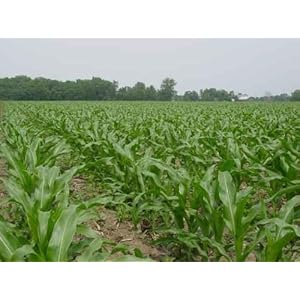Dry conditions persisting across much of the Midwest U.S. are causing nutrient deficiency problems. Unfortunately, only rainfall will fix some of these problems.
Foliar or soil application of nutrients is not recommended, according to University of Illinois assistant professor of crop sciences Fabián Fernández.
 Many corn fields show potassium deficiency even though adequate fertility is present in the soil. Why is potassium deficiency showing up in corn more often than any other nutrient deficiency?
Many corn fields show potassium deficiency even though adequate fertility is present in the soil. Why is potassium deficiency showing up in corn more often than any other nutrient deficiency?“The most likely reason is that, early in development, corn takes up larger amounts of potassium than of nitrogen and phosphorous,” Fernández explains. “Soon after the V12 development stage, corn has already taken up half of all the potassium it will need.”
In contrast, nitrogen and phosphorus are taken up until sometime after the dent stage (R5). Unlike nitrogen, which moves freely over large distances in the soil solution, phosphorous and potassium can move only a few millimeters at most; thus, when the soil dries out, their position makes them unavailable to the crop.
The reason this happens is that pore space in the soil contains water and air. Plant-available potassium ions are dissolved in the soil water or attached to soil particles ready to come into solution as the plant needs them. When there is sufficient water in the soil, the potassium ions dissolved in water have to travel (by diffusion) only a short distance to be taken up by the crop.
As the soil dries out, the pore space fills with air. The potassium ion has to travel across a larger distance to reach the root because it cannot diffuse through air. Increased diffusion time can cause important reductions in potassium availability to corn during vegetative stages when potassium demands are large.
“Under dry conditions, the soil is unable to keep up with the crop demand even though there might be sufficient potassium in the soil,” Fernández explained.
While there is nothing that can be done to solve the current drought problems, this year has taught producers a number of important lessons.
“For the future, I recommend that we minimize the effect of drought by ensuring that any water in the soil is protected to be used by the crop,” Fernández said. “This year, some farmers have seen firsthand how much water weeds can take up when not treated early in the season.”
Similarly, too much tillage in some situations has caused unnecessary water evaporation from the soil and those fields are running out of water sooner than those that were managed more carefully.
Source: University of Illinois
Farm Supply
Farm Magazines
Plant Roots: Growth, Function and Interactions with the Soil
Artwork: Corn Field
No comments:
Post a Comment